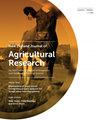Relationships between dietary factors and nitrogen partitioning to milk and urine in temperate grazing dairy cattle
IF 1.5
3区 农林科学
Q2 AGRICULTURE, MULTIDISCIPLINARY
New Zealand Journal of Agricultural Research
Pub Date : 2023-11-12
DOI:10.1080/00288233.2023.2278734
引用次数: 0
Abstract
ABSTRACTUrinary nitrogen (UN) excretion and milk production traits of 35 groups of 15 grazing cows each were measured over two years. Urine volume and N concentration were measured with urine sensors and daily UN excretion was calculated for four consecutive days. Milk yield, composition and cow liveweight (LW) were used to estimate daily dry matter intakes (DMI) based on back-calculated animal energy requirements and feed metabolisable energy (ME). Different N fractions in the diet were estimated using laboratory data and protein digestion equations. Mean estimates of N intake and UN excretion were 460 and 227 g N/d, respectively. Urinary-N represented 52% of the N consumed, which aligns with indoor N balance studies. Urinary N excretion was weakly correlated (r = 0.29) with dietary N intake, but moderately correlated (r = 0.63–0.67) with diet N concentration, diet N:ME ratio, and diet effective rumen degradable protein (ERDP). The ERDP balance had moderate to strong correlations with N utilisation efficiency (r = −0.89) and the UN expressed relative to N intake (r = 0.59) and N in milk (r = 0.78). These relationships illustrate the potential of urine sensors and energy-based estimations of intake to assess the influence of dietary management strategies to mitigate UN excretion from grazing animals.KEYWORDS: Urine sensorsnitrogenmilk proteinrumen degradable proteinintake AcknowledgementsData collection and analyses in this study were conducted under the Low N Livestock and Low N Systems programmes, which are funded by New Zealand dairy farmers through DairyNZ Incorporated and by the Ministry of Business, Innovation and Employment (contract #DRCX1701). Additional co-funding and in-kind support are received from CRV and Fonterra. We are thankful to the staff at each of the sites used to collect the data during the field studies, as well as staff at DairyNZ for the collation of different streams of data for the analyses presented here.Disclosure statementNo potential conflict of interest was reported by the author(s).Additional informationFundingThis work was supported by DairyNZ [Grant Number CRS2651]; Ministry of Business, Innovation and Employment [Grant Number DRCX1701].饲粮因素与温带放牧奶牛氮对奶和尿分配的关系
摘要对35组15头放牧奶牛进行了为期2年的氮素排泄和产奶量性状测定。用尿液传感器测量尿量和氮浓度,连续4天计算每日UN排泄量。根据动物能量需要量和饲料代谢能(ME),采用产奶量、成分和奶牛活重(LW)估算日干物质采食量(DMI)。利用实验室数据和蛋白质消化方程估算饲粮中不同N组分。平均估计N摄入量和UN排泄量分别为460和227 g N/d。尿氮占所消耗氮的52%,这与室内氮平衡研究一致。尿氮排泄量与饲粮氮摄入量呈弱相关(r = 0.29),与饲粮氮浓度、饲粮氮代谢比和饲粮有效瘤胃可降解蛋白(ERDP)呈中度相关(r = 0.63 ~ 0.67)。ERDP平衡与氮利用效率(r = - 0.89)、UN与氮摄入量(r = 0.59)和牛奶中氮含量(r = 0.78)有中强相关性。这些关系说明了尿液传感器和基于能量的摄入估计在评估饮食管理策略对减少放牧动物排泄UN的影响方面的潜力。本研究的数据收集和分析是在低氮牲畜和低氮系统项目下进行的,该项目由新西兰奶农通过dairy ynz公司和商业、创新和就业部(合同号DRCX1701)资助。CRV和恒天然还提供了额外的共同资金和实物支持。我们感谢在实地研究中收集数据的每个站点的工作人员,也感谢DairyNZ的工作人员,他们为本文提供的分析整理了不同的数据流。披露声明作者未报告潜在的利益冲突。本研究由DairyNZ支持[批准号CRS2651];经济、创新和就业部[批准号DRCX1701]。
本文章由计算机程序翻译,如有差异,请以英文原文为准。
求助全文
约1分钟内获得全文
求助全文
来源期刊
CiteScore
4.90
自引率
16.70%
发文量
31
审稿时长
3 months
期刊介绍:
The New Zealand Journal of Agricultural Research publishes original research papers, review papers, short communications, book reviews, letters, and forum articles. We welcome submissions on all aspects of animal and pastoral science relevant to temperate and subtropical regions. The journal''s subject matter includes soil science, fertilisers, insect pests, plant pathology, weeds, forage crops, management systems, agricultural economics, agronomy, and animal science. The journal also accepts crossover papers on subjects such as land –water interactions.

 求助内容:
求助内容: 应助结果提醒方式:
应助结果提醒方式:


